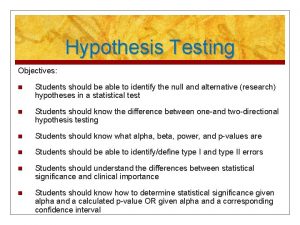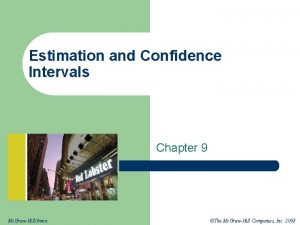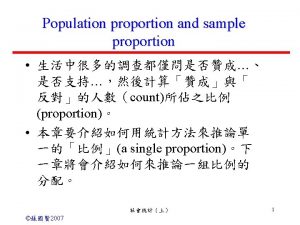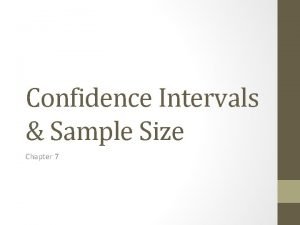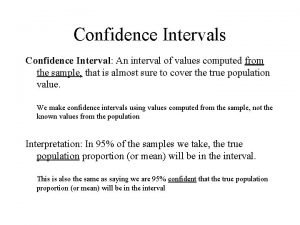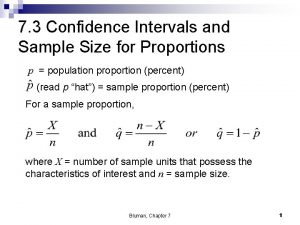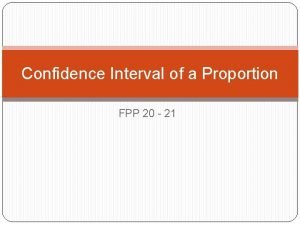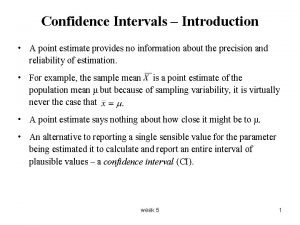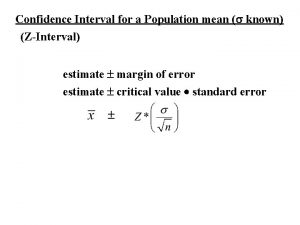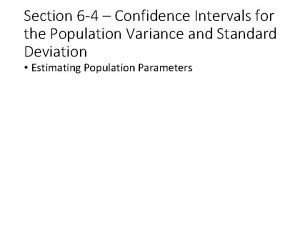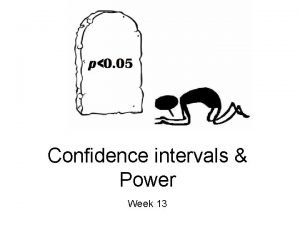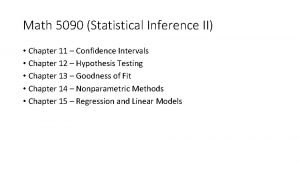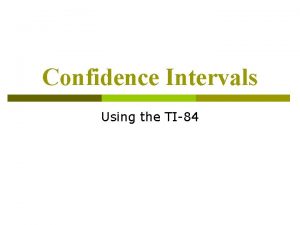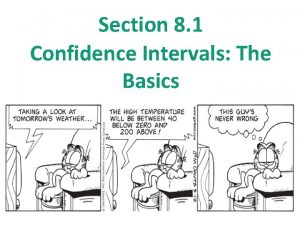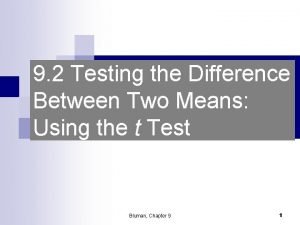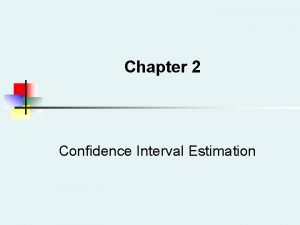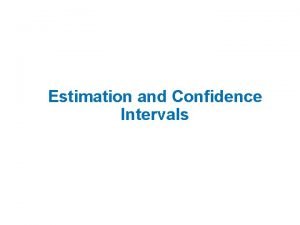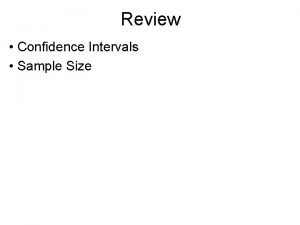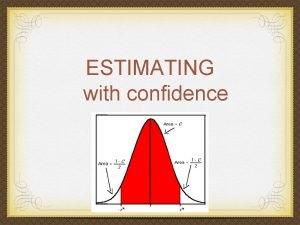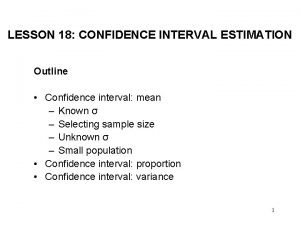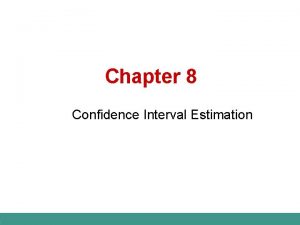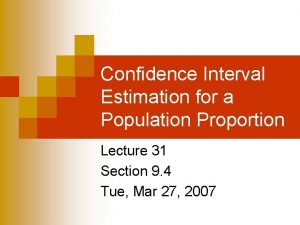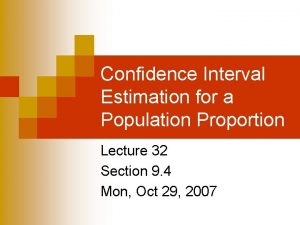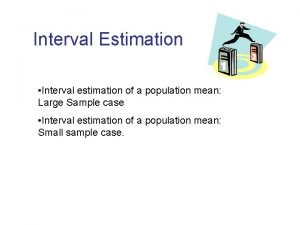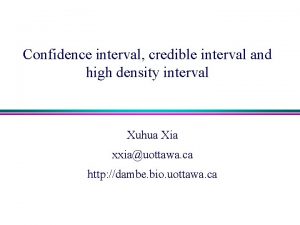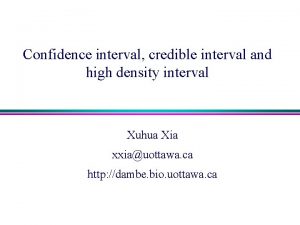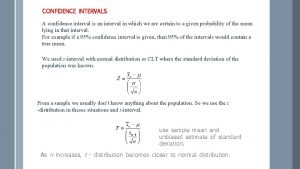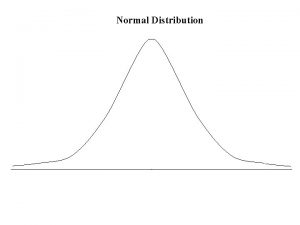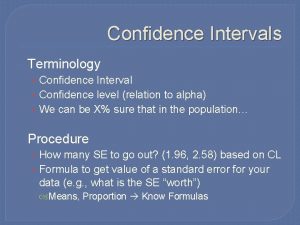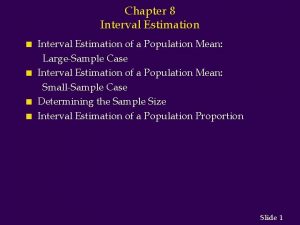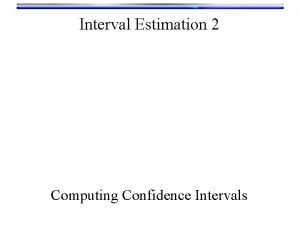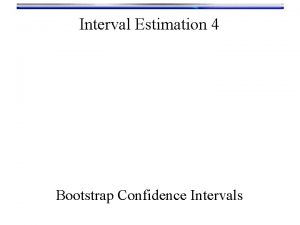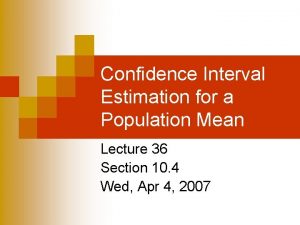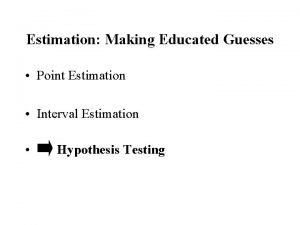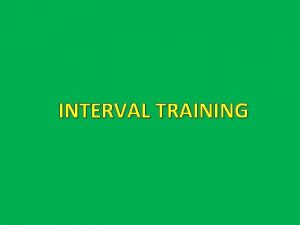Confidence Interval Estimation for a Population Proportion Lecture























- Slides: 23

Confidence Interval Estimation for a Population Proportion Lecture 33 Section 9. 4 Tue, Mar 22, 2005

Point Estimates Point estimate – A single value of the statistic used to estimate the parameter. n The problem with point estimates is that we have no idea how close we can expect them to be to the parameter. n That is, we have no idea of how large the error may be. n

Interval Estimates Interval estimate – an interval of numbers that has a stated probability (often 95%) of containing the parameter. n An interval estimate is more informative than a point estimate. n

Interval Estimates Confidence level – The probability that is associated with the interval. n If the confidence level is 95%, then the interval is called a 95% confidence interval. n

Approximate 95% Confidence Intervals How do we find a 95% confidence interval for p? n Begin with the sample size n and the sampling distribution of p^. n We know that the sampling distribution is normal with mean p and standard deviation n

Approximate 95% Confidence Intervals n Therefore… n n Approximately 95% of all values of p^ are within 2 standard deviations of p. For a single random p^, there is a 95% chance that it is within 2 standard deviations of p. Therefore… n There is a 95% chance that p is within 2 standard deviations of a single random p^.

Approximate 95% Confidence Intervals n Thus, the confidence interval is The trouble is, to know p^, we must know p. (See the formula for p^. ) n The best we can do is to use p^ in place of p to estimate p^. n

Approximate 95% Confidence Intervals n That is, n This is called the standard error of p^ and is denoted SE(p^). n Now the 95% confidence interval is

Example n Example 9. 6, p. 539. The answer is (0. 178, 0. 206). n That means that we are 95% confident, or sure, that p is somewhere between 0. 178 and 0. 206. n

Let’s Do It! n Let’s do it! 9. 5, p. 540 – When Do You Turn Off Your Cell Phone?

Confidence Intervals We are using the number 2 as a rough approximation for a 95% confidence interval. n We can get a more precise answer if we use the normal tables. n A 95% confidence interval cuts off the upper 2. 5% and the lower 2. 5%. n What values of z do that? n

Standard Confidence Levels n The standard confidence levels are 90%, 95%, 99%, and 99. 9%. (See p. 542. ) Confidence Level z 90% 1. 645 95% 1. 960 99% 2. 576 99. 9% 3. 291

The Confidence Interval n The confidence interval is given by the formula where z is given by the previous chart or is found in the normal table.

Confidence Level n Rework Let’s Do It! 9. 5, p. 540, by computing a 95% confidence interval. n 90% confidence interval. n 99% confidence interval. n Which one is widest? n Which one is best? n

Probability of Error We use the symbol to represent the probability that the confidence interval is in error. n That is, is the probability that p is not in the confidence interval. n In a 95% confidence interval, = 0. 05. n

Probability of Error Thus, the area in each tail is /2. n The value of z can be found by using the inv. Norm function on the TI-83. n For example, n 90% CI: =0. 10; inv. Norm(0. 05) = – 1. 645. n 95% CI: =0. 05; inv. Norm(0. 025) = – 1. 960. n 99% CI: =0. 01; inv. Norm(0. 005) = – 2. 576. n 99. 9% CI: =0. 001; inv. Norm(0. 0005) = – 3. 291. n

Values of z Confidence Level 90% 95% 99. 9% 0. 10 0. 05 0. 01 0. 001 inv. Norm( /2) -1. 645 -1. 960 -2. 576 -3. 291

Think About It Think about it, p. 542. n Which is better? n A wider confidence interval, or n A narrower confidence interval. n n Which is better? A low level of confidence, or n A high level of confidence. n

Think About It n Which is better? A smaller sample, or n A larger sample. n What do we mean by “better”? n Is it possible to increase the level of confidence and make the confidence narrower at the same time? n

TI-83 – Confidence Intervals The TI-83 will compute a confidence interval for a population proportion. n Press STAT. n Select TESTS. n Select 1 -Prop. ZInt. n

TI-83 – Confidence Intervals A display appears requesting information. n Enter x, the numerator of the sample proportion. n Enter n, the sample size. n Enter the confidence level, as a decimal. n Select Calculate and press ENTER. n

TI-83 – Confidence Intervals n A display appears with several items. The title “ 1 -Prop. ZInt. ” n The confidence interval, in interval notation. n The sample proportion p^. n The sample size. n n How would you find the margin of error?

TI-83 – Confidence Intervals n Rework Let’s Do It! 9. 5, p. 540, using the TI 83.
 Confidence interval vs confidence level
Confidence interval vs confidence level Confidence interval z value
Confidence interval z value Confidence interval formula proportion
Confidence interval formula proportion Sampling distribution of the proportion
Sampling distribution of the proportion Sample size
Sample size Confidence interval for proportion excel
Confidence interval for proportion excel Confidence interval for sample proportion
Confidence interval for sample proportion Confidence interval for sample proportion
Confidence interval for sample proportion Confidence interval for sample proportion
Confidence interval for sample proportion Z table for 95 confidence interval
Z table for 95 confidence interval Confidence interval for population mean
Confidence interval for population mean Confidence interval for population mean
Confidence interval for population mean Confidence interval for population variance formula
Confidence interval for population variance formula How to report a confidence interval
How to report a confidence interval Pivot confidence interval
Pivot confidence interval Ti 84 confidence interval
Ti 84 confidence interval Interval notation for infinity
Interval notation for infinity 96 confidence interval z score
96 confidence interval z score Confidence interval difference of means
Confidence interval difference of means Level of confidence in statistics
Level of confidence in statistics Confidence interval example
Confidence interval example 68 confidence interval
68 confidence interval 96 percent confidence interval
96 percent confidence interval Confidence interval with margin of error calculator
Confidence interval with margin of error calculator
